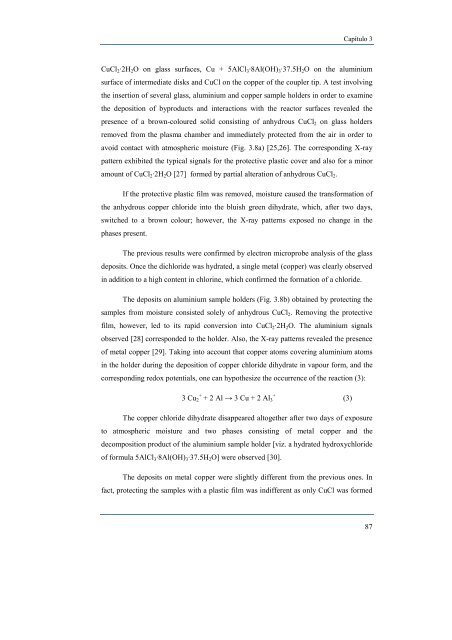estudio y caracterización de un plasma de microondas a presión ...
estudio y caracterización de un plasma de microondas a presión ...
estudio y caracterización de un plasma de microondas a presión ...
Create successful ePaper yourself
Turn your PDF publications into a flip-book with our unique Google optimized e-Paper software.
Capítulo 3<br />
CuCl2·2H2O on glass surfaces, Cu + 5AlCl3·8Al(OH)3·37.5H2O on the aluminium<br />
surface of intermediate disks and CuCl on the copper of the coupler tip. A test involving<br />
the insertion of several glass, aluminium and copper sample hol<strong>de</strong>rs in or<strong>de</strong>r to examine<br />
the <strong>de</strong>position of byproducts and interactions with the reactor surfaces revealed the<br />
presence of a brown-coloured solid consisting of anhydrous CuCl2 on glass hol<strong>de</strong>rs<br />
removed from the <strong>plasma</strong> chamber and immediately protected from the air in or<strong>de</strong>r to<br />
avoid contact with atmospheric moisture (Fig. 3.8a) [25,26]. The corresponding X-ray<br />
pattern exhibited the typical signals for the protective plastic cover and also for a minor<br />
amo<strong>un</strong>t of CuCl2·2H2O [27] formed by partial alteration of anhydrous CuCl2.<br />
If the protective plastic film was removed, moisture caused the transformation of<br />
the anhydrous copper chlori<strong>de</strong> into the bluish green dihydrate, which, after two days,<br />
switched to a brown colour; however, the X-ray patterns exposed no change in the<br />
phases present.<br />
The previous results were confirmed by electron microprobe analysis of the glass<br />
<strong>de</strong>posits. Once the dichlori<strong>de</strong> was hydrated, a single metal (copper) was clearly observed<br />
in addition to a high content in chlorine, which confirmed the formation of a chlori<strong>de</strong>.<br />
The <strong>de</strong>posits on aluminium sample hol<strong>de</strong>rs (Fig. 3.8b) obtained by protecting the<br />
samples from moisture consisted solely of anhydrous CuCl2. Removing the protective<br />
film, however, led to its rapid conversion into CuCl2·2H2O. The aluminium signals<br />
observed [28] correspon<strong>de</strong>d to the hol<strong>de</strong>r. Also, the X-ray patterns revealed the presence<br />
of metal copper [29]. Taking into acco<strong>un</strong>t that copper atoms covering aluminium atoms<br />
in the hol<strong>de</strong>r during the <strong>de</strong>position of copper chlori<strong>de</strong> dihydrate in vapour form, and the<br />
corresponding redox potentials, one can hypothesize the occurrence of the reaction (3):<br />
3 Cu2 + + 2 Al → 3 Cu + 2 Al3 + (3)<br />
The copper chlori<strong>de</strong> dihydrate disappeared altogether after two days of exposure<br />
to atmospheric moisture and two phases consisting of metal copper and the<br />
<strong>de</strong>composition product of the aluminium sample hol<strong>de</strong>r [viz. a hydrated hydroxychlori<strong>de</strong><br />
of formula 5AlCl3·8Al(OH)3·37.5H2O] were observed [30].<br />
The <strong>de</strong>posits on metal copper were slightly different from the previous ones. In<br />
fact, protecting the samples with a plastic film was indifferent as only CuCl was formed<br />
87

















